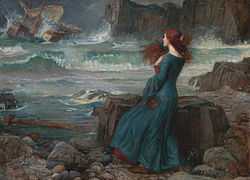The Magic Circle (Waterhouse painting)
|
| |
| Artist | John William Waterhouse |
|---|---|
| Year | 1886 |
| Type | Oil on canvas |
| Dimensions | 183 cm × 127 cm (72 in × 50 in) |
| Location | Tate Britain, London |
The Magic Circle is an oil painting in the Pre-Raphaelite style, created in 1886 by John William Waterhouse. The painting depicts a witch or sorceress drawing a fiery magic circle on the earth to create a ritual space.
History
The Magic Circle was shown at the Royal Academy in 1886,[1] and, after Consulting the Oracle and St. Eulalia, was Waterhouse's third exhibit with a supernatural theme in as many years.[2] The painting was well received at its exhibition,[2] and was purchased for £650 the same year by the Tate Gallery, through the Chantrey Bequest.[3]
The painting was extremely successful with the critics and public alike.
Description
In a style typical of Waterhouse, the main character is a lone, female figure, placed centrally on the canvas. The surrounding landscape is hazy, as though it is not quite real, and the background figures are only discernible on close inspection, deliberately ensuring the witch is the only image of importance.[4]
Waterhouse paid careful attention to the angles employed in this work, balancing the circle the figure is drawing around herself by the use of a triangle – her straight arm, extended by the straight stick, held out at 25 degrees to her erect body. The witch's power is emphasised by the determined face, by her exclusion of the ravens and frog – popular symbols representing magic – and by her command over the smoke pillar. Instead of billowing outwards or being affected by the wind, it remains in a straight line. A live snake ouroboros loops around the woman's neck.
The Magic Circle is similar in composition to Waterhouse's later picture, Miranda (1916), also a woman associated with magic. The witch wears a similar dress to Miranda and her face can also only be seen in profile. Unlike Frederick Sandys' portrayals of sorceresses, such as his Medea (1868) or Morgan le Fay (1864), Waterhouse chose to make his witch's face intent and intriguing, as opposed to malevolent.
Themes
Miracles, magic and the power of prophecy are common themes in Waterhouse's art. More specifically, the notion of woman as enchantress is one that recurs in images such as Circe Offering the Cup to Ulysees (1891, Oldham Art Gallery) and Hylas and the Nymphs (1896, Manchester City Art Gallery). His oeuvre also includes a number of middle-eastern subjects, in which he drew on the work of contemporary artists such as J.F Lewis (1805–76) and Lawrence Alma-Tadema (1836–1912), rather than on actual experience. This is one of Waterhouse's earlier works, and reflects his fascination with the exotic.
The woman in this picture appears to be a witch or priestess, endowed with magic powers, possibly the power of prophecy. Her dress and general appearance is highly eclectic, and is derived from several sources: she has the swarthy complexion of a woman of middle-eastern origin; her hairstyle is like that of an early Anglo-Saxon; her dress is decorated with Persian or Greek warriors. In her left hand she holds a crescent-shaped sickle, linking her with the moon and Hecate. With the wand in her right hand she draws a protective magic circle round her. Outside the circle the landscape is bare and barren; a group of rooks or ravens and a frog – all symbols of evil and associated with witchcraft – are excluded. But within its confines are flowers and the woman herself, objects of beauty.
The meaning of the picture is unclear, but its mystery and exoticism struck a chord with contemporary observers. When the picture was exhibited at the Royal Academy in 1886 the critic for the Magazine of Art wrote 'Mr Waterhouse, in The Magic Circle, is still at his best – original in conception and pictorial in his results' (quoted in Hobson, p.37)[5]
See also
References

- ↑ "Tate - Website undergoing maintenance". tate.org.uk.
- ↑ 2.0 2.1 Christie's. "John William Waterhouse, R.A. (1848-1917)". christies.com.
- ↑ "J. W. Waterhouse". johnwilliamwaterhouse.com.
- ↑ "Tate - Website undergoing maintenance". tate.org.uk.
- ↑ "The Magic Circle, John William Waterhouse: Summary - Tate". Tate.
Further reading
- Moyle, Franny (13 June 2009), "Pre-Raphaelite art: the paintings that obsessed the Victorians [print version: Sex and death: The paintings that obsessed the Victorians]", The Daily Telegraph (Review): R2–R3.
- Simpson, Eileen (17 June 2009), "Pre-Raphaelites for a new generation: Letters, 17 June: Pre-Raphaelite revival", The Daily Telegraph.
- Dorment, Richard (29 June 2009), "Waterhouse: The modern Pre-Raphaelite, at the Royal Academy – review", The Daily Telegraph.
External links
| Wikimedia Commons has media related to John William Waterhouse. |
- The Magic Circle at johnwaterhouse.com.
- johnwilliamwaterhouse.net
- John William Waterhouse (The Art and Life of JW Waterhouse);
- John William Waterhouse (Comprehensive Painting Gallery)
- John William Waterhouse Style and Technique
- Waterhouse at Tate Britain
- Ten Dreams Galleries
- John William Waterhouse in the "History of Art"